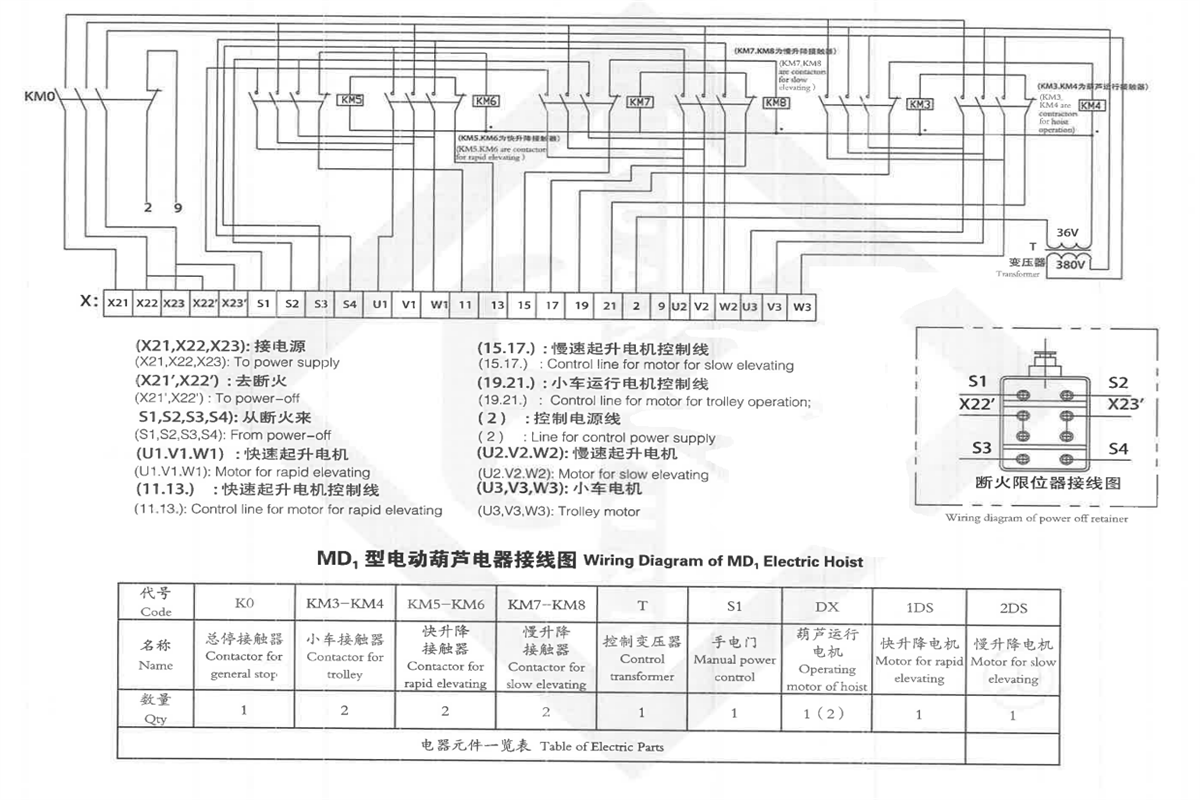| Table 1-1 Monorail Wire Rope Electric Hoist Classification | ||
| CD1 | monorail wire rope electric hoist | The most popular used electric hoist, hoisting motor, reel and gear box are arranged in series mode. In a round shape, it lifts and lower in vertical direction and movement in horizontal direction, working in lower speed. |
| MD1 | monorail wire rope electric hoist | On base of CD1 electric hoist, MD1 is added a set of low-speed lifting driving device, consisting of low-speed motor and gear box, with a speed ratio: 10:1. When the high-speed motor works, the low-speed driving device standby and the electric hoist lift in a high speed; When low-speed motor is drive, the lifting motor rotates at a low speed, the electric hoist lowers slowly |
| HC | monorail wire rope electric hoist | In a box structure, this kind of hoist is used for large lifting tonnages, its other structures are the same as CD type. |
| HY1 | monorail wire rope electric hoist (for hoisting molten metal) |
An improved product with special design on the base of CD and MD hoist, which fitted with protection of high temperature resistance and heat-insulating, lifting mechanism is fitted with double limit switch, working class is up to M6. When the rated lifting capacity exceeds 5t, not only a working brake is set on the hoist, but also a safe brake is equipped on the low rotating class transmission shaft. When the rated lifting capacity is smaller than or equal to 5t, the electric hoist is designed by 1.5 times of its rated lifting capacity. |
| BCD | explosion proof monorail wire rope electric hoist | On base of CD1 electric hoist, adding explosion proof measures to motor, electrical device and partial components. Depending on different operating enviroments, there are gas explosion proof and dust explosion proof. |
| BMD | explosion proof monorail wire rope electric hoist | On base of MD1 electric hoist, adding explosion proof measures to motor, electrical device and partial components. Depending on different operating environments, there are gas explosion proof and dust explosion proof. |
| GB3811 | Design Rules for Cranes |
| JB/T 9008.1 | Wire Rope Electric Hoist Part 1: Model, Basic Parameters and Technical Conditions |
| JB/T 9008.2 | Wire Rope Electric Hoist Part 2: Test Methods |
| GB 3836.1 | Explosive Environment Part 1: General Requirements on Equipment |
| GB 12476.1 | Electrical Appliance General Requirements Used in Combustible Dust Part 1: |
| JB/T 10222 | Explosion-proof Electric Hoists |
| JB/T 3907 | Button Switch |
| GB 12602 | Lifting Appliances-Safety Devices Overloading Protection |
| GB 8918 | Wire Ropes for lmportant Purposes |
| Table 1-2 Impact on Environment | ||
| Item | lmpact on Environment | Preventative Measure |
| When installing, maintaining or disassembling | A certain amount of solid waste will be generated during construction | Disposal following local regulations |
| When lubricating oil leaks | Cause soil and water pollution | Check the leakage point and repair until no leakage is found |
| When replacing lubricating oil | Pollute soil and water due to uncontrolled discharge | Waste grease shall be collected in dedicated containers |
| When meshing points wear out severely | Noise exceed the limits, influence the operator | Calibrate, adjust or replace worn parts |
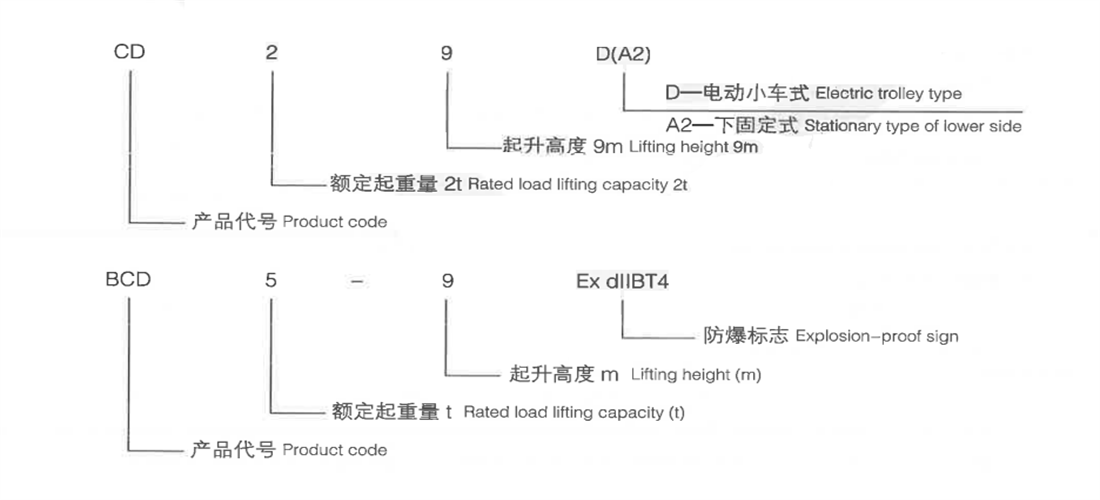
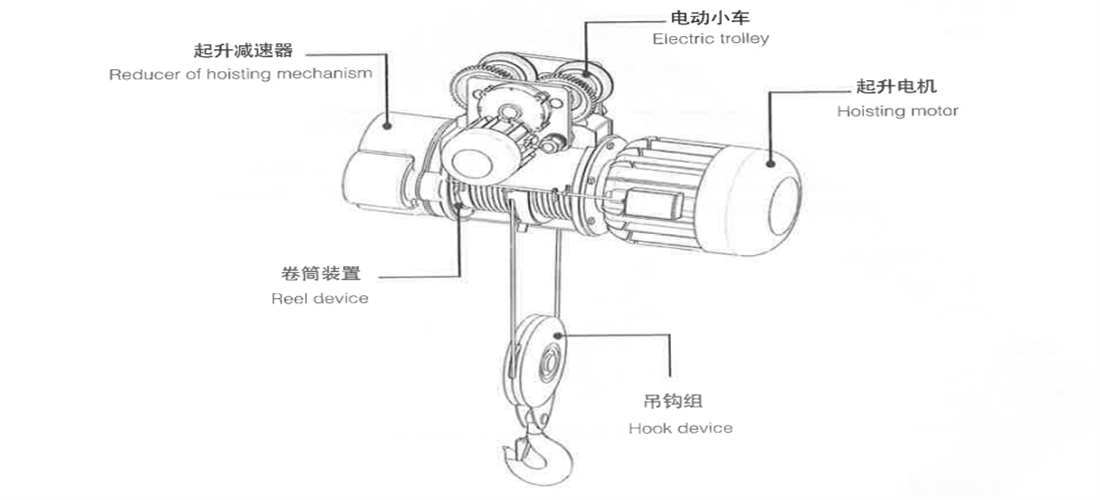
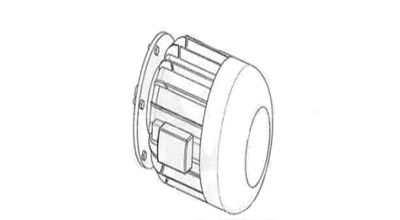
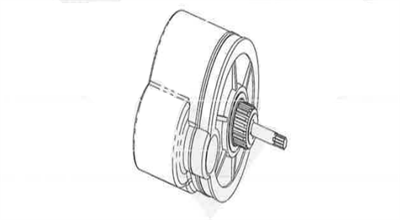
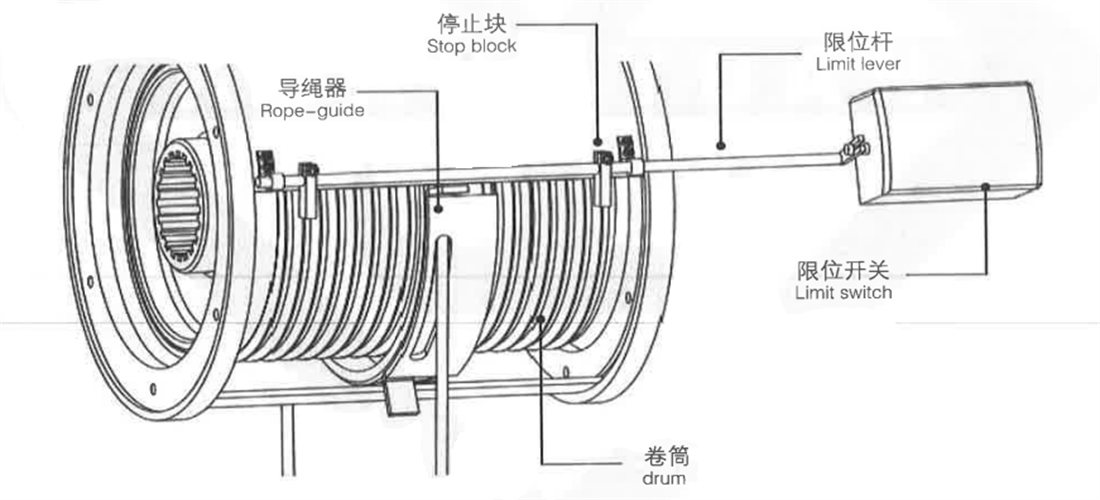
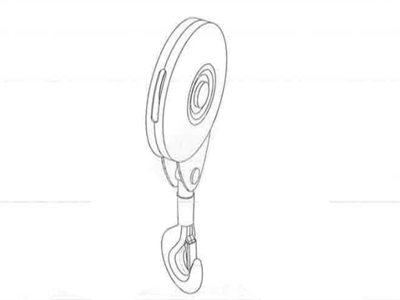
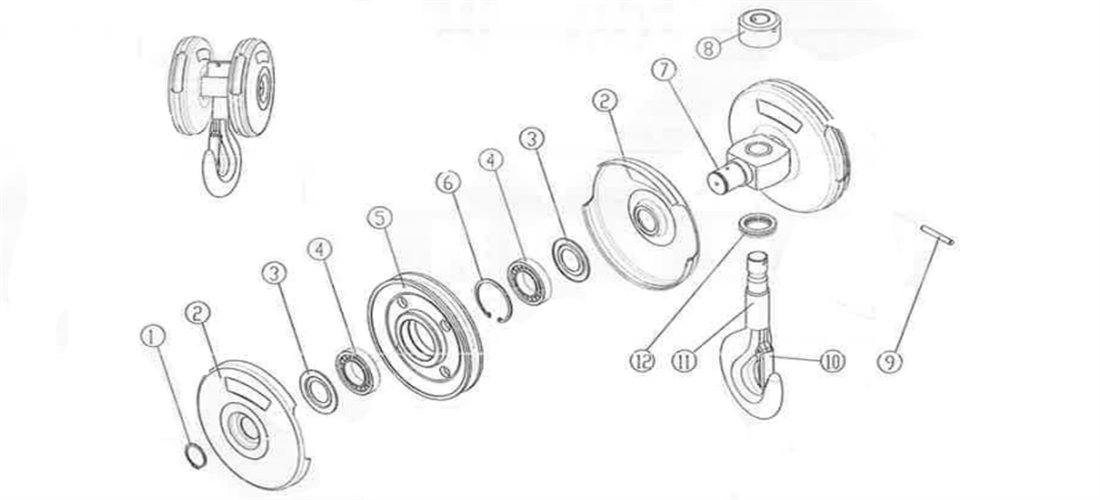
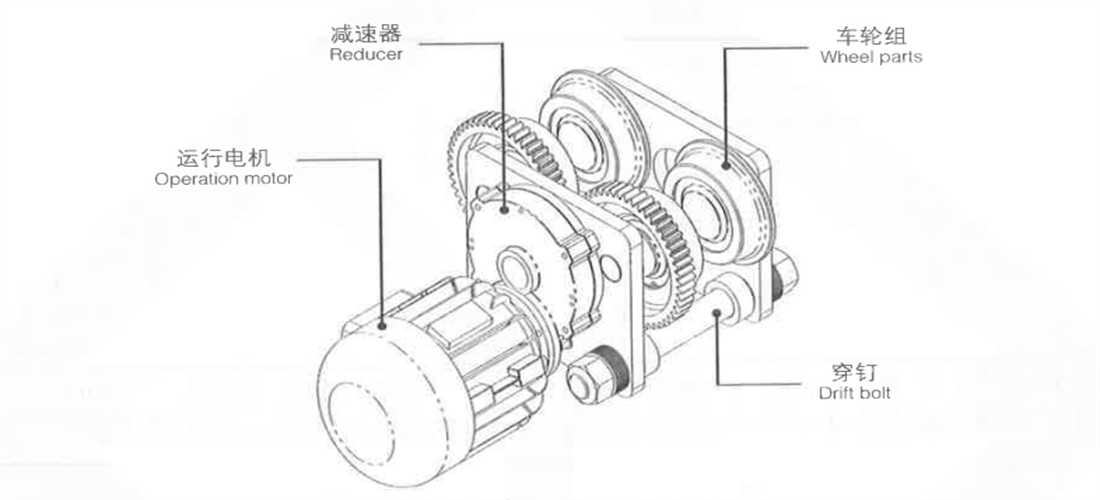
| Technical Parameter | ||||||||||||||||||||||
| Lifting Capacity(T) | 0.5 | 1 | 3 | 5 | 10 | 20 | 32 | |||||||||||||||
| Lifting Height(M) | 3 | 6 | 9 | 6 | 12 | 30 | 6 | 12 | 30 | 6 | 12 | 30 | 9 | 12 | 30 | 9 | 12 | 30 | 12 | 20 | 24 | |
| Lifting Speed(m/min) | 8/0.8 | 8/0.8 | 8/0.8 | 8/0.8 | 7/0.7 | 4.2/0.42 | 3/0.3 | |||||||||||||||
| Cross speed(m/min) | 20 | 20/30 | 20/30 | 20/30 | 20/30 | 21.5 | 26 | |||||||||||||||
| wire rope | Dia(mm) | 3.6 | 4.8 | 13 | 15 | 15 | 19.5 | 26 | ||||||||||||||
| Structure | 6*19 | 6*37+1 | 6*37+1 | 6*37+1 | 6*37+1 | 6*37+1 | 6*37+1 | |||||||||||||||
| Traveling Track | 16-28b | 16-28b | 20a-32c | 25a-45c | 30T-45c | 40b-63c | above 63c | |||||||||||||||
| Min Curvature Radius(m) | 1.5 | 1.5 | 2 | 4 | 2 | 2.5 | 4 | 2.5 | 3 | 6 | 3.5 | 4 | 9 | 3.5 | 4 | |||||||
| Lifting Motor | power(kw) | 0.2/0.8 | 0.4/1.5 | 0.4/4.5 | 0.8/7.5 | 1.5/13 | 2.2/18.5 | 2.2/18.5 | ||||||||||||||
| Rotation speed (r/min) | 1380 | 1380 | 1380 | 1380 | 1380 | 1380 | 1380 | |||||||||||||||
| Current(A) | 0.72/2.4 | 12.5/4.3 | 1.25/11 | 2.4/18 | 4.3/30 | 42 | 43 | |||||||||||||||
| Cross Motor | power(kw) | 0.2 | 0.2 | 0.4 | 0.8 | 0.8*2 | 0.8*4 | 0.8*4 | ||||||||||||||
| Rotation speed (r/min) | 1380 | 1380 | 1380 | 1380 | 1380 | 1380 | 1380 | |||||||||||||||
| Current(A) | 0.72 | 0.72 | 1.25 | 2.4 | 2.4 | 4.3 | 4.3 | |||||||||||||||
| Basic size | L | 616 | 688 | 760 | 758 | 954 | 1542 | 915 | 1121 | 1738 | 1047 | 1257 | 1887 | 1602 | 1783 | 2869 | 1747 | 1942 | 2997 | 2127 | 2697 | 2982 |
| L1 | 274 | 346 | 418 | 345 | 541 | 1129 | 380 | 586 | 1204 | 415 | 625 | 1255 | 875 | 1056 | 2142 | 948 | 1143 | 2409 | 1270 | 1840 | 2125 | |
| L2 | 125 | 158 | 229 | 267 | 301 | 330 | 396 | |||||||||||||||
| L3 | 318 | 390 | 462 | 401 | 597 | 1185 | 448 | 654 | 1272 | 485 | 695 | 1325 | 949 | 1130 | 2216 | 1053 | 1246 | 2301 | 1130 | 1700 | 1985 | |
| L4 | 190 | 1961 | 264 | 320 | 376 | 670 | 600 | |||||||||||||||
| B | 884 | 884 | 930 | 1058 | 1058 | 548 | 743 | 2009 | 320 | |||||||||||||
| H | 650 | 667 | 767 | 954 | 1058 | 1120 | 1283 | 1350 | 288-310 | 2500(1500) | ||||||||||||
| D | 14.5 | 19 | 25 | 31 | 30 | 25 | 25 | |||||||||||||||
| Self weight | Lifting single speed | 121 | 125 | 130 | 137 | 172 | 220 | 281 | 354 | 451 | 437 | 597 | 726 | 1048 | 1098 | 1411 | 2450 | 1927 | 2169 | 2950 | 3495 | 3700 |
| Lifting double speed | 138 | 142 | 147 | 164 | 199 | 247 | 311 | 384 | 481 | 530 | 654 | 783 | 1104 | 1154 | 1467 | |||||||

.png)
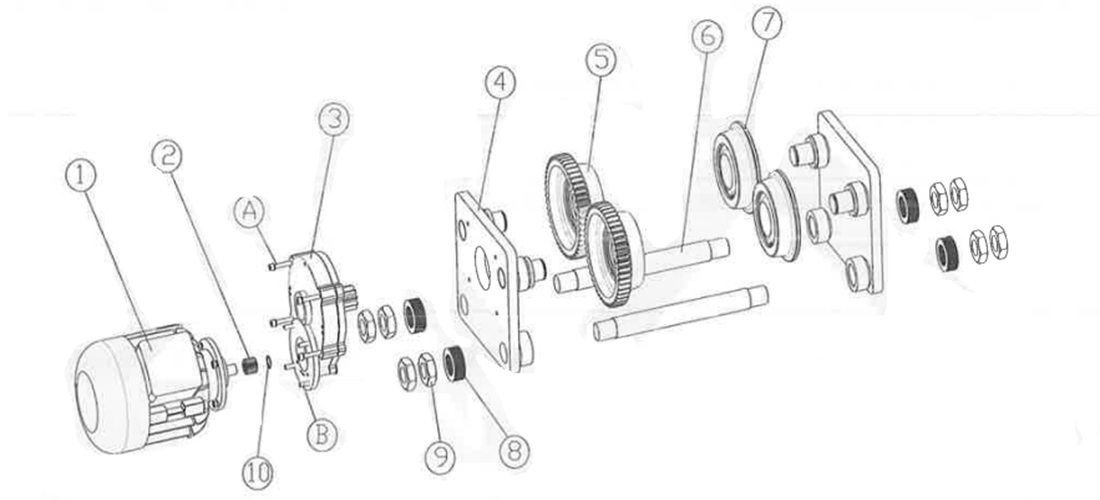

| I beam rail model GB/T706 | Rated lifting capacity(t) | |||
| 0.5~1 | 2~3 | 5~10 | 16~20 | |
| 16 | 0 | |||
| 18 | 2 | |||
| 20a | 3 | 0 | ||
| 20b | 4 | 1 | ||
| 22a | 6 | 3 | ||
| 22b | ||||
| 25a | 7 | 4 | 0 | |
| 25b | 8 | 5 | 1 | |
| 28a | 9 | 6 | 2 | |
| 28b | ||||
| 32a | 8 | 4 | ||
| 32b | ||||
| 32c | 9 | 5 | ||
| 36a | 5 | |||
| 26b | 10 | 6 | 6 | |
| 36c | ||||
| 40a | 11 | 7 | 7 | |
| 40b | ||||
| 40c | 12 | 8 | 8 | |
| 45a | 13 | 9 | 9 | |
| 45b | ||||
| 45c | 14 | 10 | 10 | |
| 50a | 11 | 11 | ||
| 50b | 11 | 11 | ||
| 50c | 12 | 12 | ||
| 56a | 13 | 13 | ||
| 56b | 13 | 13 | ||
| 56c | 14 | 14 | ||
| 63a | 15 | 15 | ||
| 63b | 16 | 16 | ||
| 63c | 16 | 16 | ||


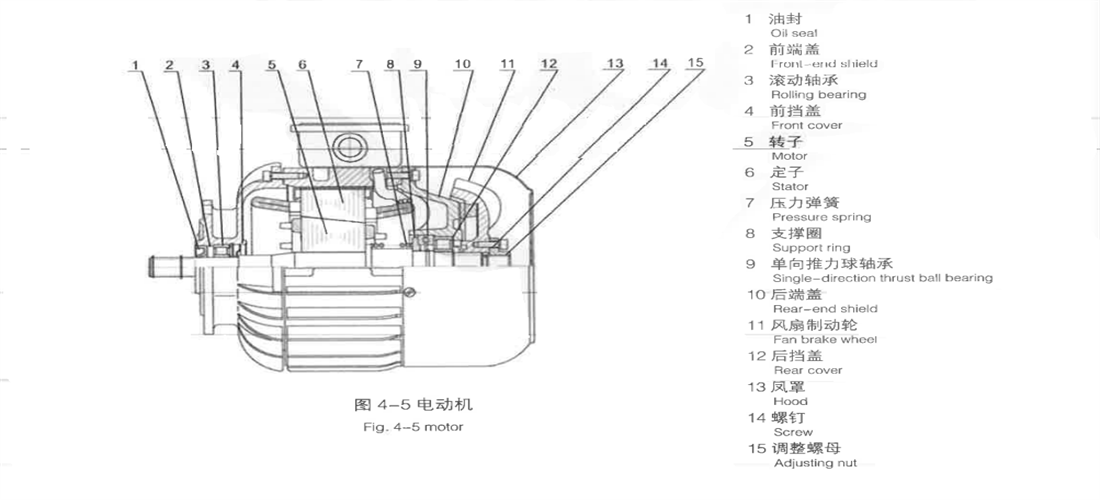
.png)
.png)
.png)
.png)


.png)
| Daily inspection and inspection items, content, methods and requirements | ||||||||
| No. | Item | Inspection methods, content and requirements | Processing methods | Cycle | ||||
| day | month | quarter | year | |||||
| 1 | Technical documents | Accompanying files | Check that the accompanying drawings, user manual, and factory certificate are complete | Improvement | ○ | |||
| 2 | Inspection records | Previous inspection records should be complete and free from any unresolved defects | Improvement | ○ | ||||
| 3 | Maintain records | Check that previous maintenance records are complete and have no unverified maintenance | Improvement | ○ | ||||
| 4 | Other archives | Check other files such as equipment installation, renovation, maintenance, registration, etc. | Improvement | ○ | ||||
| 5 | Whole machine | Operation environment | Visually inspect the operating environment of the equipment to ensure that there are no factors affecting the safety of the operation | Handle according to the enterprise management system and operating procedures | ○ | ○ | ○ | ○ |
| 6 | Appearance | Visually inspect all parts of the equipment to ensure there is no garbage, debris, missing tools, etc. | Cleaning | ○ | ○ | ○ | ○ | |
| 7 | Visually inspect all parts of the equipment to ensure there is no oil or water accumulation | Cleaning | ○ | ○ | ○ | |||
| 8 | Visually inspect the surfaces of the equipment to ensure that there are no serious defects such as rust, paint peeling, or damage | Corrosion prevention/repair | ○ | ○ | ○ | |||
| 9 | Wheel loading condition | Visually inspect each wheel of the equipment to ensure there is no overhang | Adjustment | ○ | ||||
| 10 | Metal structure | Hull shell and trolley frame | The measurement and inspection equipment shell and trolley frame should have no plastic deformation, and the welds of the main load-bearing structural components should have no visible cracks | Repair/Replacement |
○ | |||
| 11 | Connecting pieces | Connecting bolts | Visually inspect the connecting bolts of the main load-bearing components, safety devices, motors, reducers, etc. for any defects or looseness | Tighten/replace | ○ | |||
| 12 | mechanism | Lifting mechanism | Through no-load test, it is found that the lifting mechanism should have no abnormal sound or vibration and operate smoothly | Maintenance | ○ | ○ | ○ | ○ |
| 13 | Trolley travelling mechanism | Check that the operating mechanism has no abnormal sound or vibration through no-load testing | Maintenance | ○ | ○ | ○ | ○ | |
| 14 | Visually inspect the equipment to ensure that there are no deviations, scratches, etc. that may affect its use | Adjustment/change | ○ | ○ | ||||
| 15 | Trolley power supply device | Check the power supply device of the car through no-load test to ensure there is no abnormal sound or vibration | Maintenance | ○ | ○ | |||
| 16 | Key component | Lifting hook | Visually check that the lifting hook can rotate freely and that the fixing bolts are not loose | Repair/change | ||||
| 17 | Check by eye that lifting hook blocking device and hook nut anti-loose device should be effective | Repair/change | ○ | ○ | ○ | |||
| 18 | Inspect the surface cracks, deformation, wear, and corrosion of forged hooks according to the methods specified in GB/T10051.2 and GB/T10051.3, and ensure they meet the requirements | Repair/change | ○ | ○ | ○ | |||
| 19 | Pulley | Visually check that the pulley should rotate flexibly | Lubricate/adjust | ○ | ||||
| 20 | Visual inspection of the pulley anti detachment device should be safe and effective | Repair/change | ○ | ○ | ||||
| 21 | Visual inspection of the pulley should comply with the provisions of 4.2.5.3 in GB6067.1-2010, and the uneven wear of the wheel groove should be less than 3u. The wear of the wheel groove wall thickness is less than 20% of the original wall thickness, and the wear of the bottom of the wheel groove is less than 25% of the diameter of the steel wire rope; There must be no other defects that damage the copper wire rope. | Change | ○ | ○ | ||||
| 22 | Wire rope | Inspect the steel wire rope according to the method specified in GB/T5972 and meet its requirements | Change | ○ | ○ | |||
| 23 | Visually inspect the wire rope for obvious mechanical damage | Repair/change | ○ | ○ | ○ | |||
| 24 | Visually inspect the steel wire ropes on the drum and pulley to ensure they are wrapped properly and free from any loose ropes | Maintenance | ○ | ○ | ○ | ○ | ||
| 25 | Visually inspect the fixation of the end of the steel wire rope and ensure that it meets the corresponding requirements | Fastening/ adjustment |
○ | ○ | ○ | |||
| 26 | Monthly inspection of the steel wire rope table without obvious exposed broken wires | Repair/change | ○ | ○ | ○ | |||
| 27 | Reel | Visual inspection of the drum should comply with the provisions of 4.24.5 in GB6067.1-2010 | Change | ○ | ||||
| 28 | Gear box | Visually inspect the gearbox during operation to ensure that there are no abnormal sounds, vibrations, oil leaks, or overheating | Maintenance | ○ | ○ | ○ | ||
| 29 | Visually check that the oil level should be within the required range | Refuel | ○ | ○ | ○ | |||
| 30 | The allowable wear of the first level gear of the lifting mechanism should be less than 10% of the original tooth thickness; Other gears should be less than 20%. | Change | ○ | |||||
| 31 | The allowable wear of the first level gear of the operating mechanism should be less than 15% of the original tooth thickness; Other gears should be less than 25%, and open gears should be less than 30%. | Change | ○ | |||||
| 32 | There should be no cracks or broken teeth on the teeth; The pitting damage on the tooth surface shall not exceed 30% of the mating surface, and the depth shall not exceed 10% of the original tooth thickness. | Change | ○ | |||||
| 33 | There should be no cracks on the surface, and there should be no plastic deformation on the bolt part, dangerous section, and neck. Defects should not be repaired by welding. | Change | ○ | |||||
| 34 | Lifting brake | Visually inspect the sliding amount of the lifting brake of the equipment, which should be less than 1/100 of the lifting distance per minute and should not exceed 200mm | Adjustment/repair | ○ | ||||
| 35 | Visually inspect the wear of the lifting brake, and the conical brake should be able to meet the requirements for rotor displacement stroke through adjustment; The wear of the brake lining of the disc brake shall comply with the provisions of 4.2.6.7 in GB 6067.1-2010 | Change | ○ | ○ | ||||
| 36 | Wheel | Visual inspection of wheel rims and tread wear and deformation should comply with the provisions of 4.2.7 in GB 6067.1-2010 | Change | ○ | ○ | |||
| 37 | Coupling | Visually inspect the coupling for any abnormal vibration or noise during operation | Repair/change | ○ | ○ | |||
| 38 | Bearing | Visually inspect the bearings for no abnormal noise or temperature rise | Lubricate/change | ○ | ○ | |||
| 39 | Rope guide | Visually check that when the empty hook descends, the steel wire rope should be able to freely discharge from the rope guide outlet, and the guide slider of the rope guide should slide smoothly | Maintenance | ○ | ○ | ○ | ||
| 40 | Electrical control system | Power supply | Visually check that power supply works normally | Maintenance | ○ | ○ | ○ | ○ |
| 41 | Control device | Visually check that the remote control device and button device casing are not damaged, the control button identification is clear and correct, and the function is normal | Repair/change | ○ | ○ | ○ | ○ | |
| 42 | Motor | The measurement of motor insulation resistance should comply with the provisions of various product standards | Maintenance | ○ | ○ | |||
| 43 | Main power switch | Visually check that the main power switch is functioning properly | Repair/change | ○ | ○ | ○ | ||
| 44 | Resistance value | The insulation resistance to ground of the circuit shall not be less than 1MΩ. | Maintenance | ○ | ||||
| 45 | The resistance value of the track grounding connection should not exceed 0.1 Ω. | Maintenance | ○ | |||||
| 46 | Power feeding device | Visually inspect the cable protective layer to ensure that there is no severe aging, damage, or bulging, and the cable retraction measures should be complete and limited; The collector should have reliable contact | Maintenance/change | ○ | ○ | |||
| 47 | Control cabinet and electrical appliance | Visually inspect the electrical circuits and components inside the control cabinet to ensure that there are no signs of overheating, burning, or melting; The components should have no external damage; The cover should not fall off | Change | ○ | ○ | ○ | ||
| 48 | Visually inspect the electrical connections and grounding for reliability, and ensure that the cables are not severely cracked or damaged | Adjustment/change | ○ | |||||
| 49 | Visually inspect each section of the line for clear markings and ensure that the wiring is not loose | Clean/fasten | ○ | |||||
| 50 | The circuit should be checked for overheating through functional testing, and the insulation resistance should meet the requirements | Repair/change | ○ | |||||
| 51 | Check by eye that all binding posts, contacts and relays should be in good contact | Adjustment/change | ○ | ○ | ||||
| 52 | Safety protection device | Lifting height limiter | Through functional testing, check that the lifting height limiter is fixed and reliable, and its function is effective | Fasten/change | ○ | ○ | ○ | ○ |
| 53 | Secondary lifting height limiter | Through functional testing, check that the secondary lifting height limiter is fixed and reliable, and its function is effective | Fasten/change | ○ | ||||
| 54 | Overload limiter | Through functional testing, it is checked that the overload limiter should be fixed and reliable, and its function is effective | Fasten/change | ○ | ||||
| 55 | Interlock protection | Check that the electrical interlocking protection device is effective through functional testing | Adjustment/change | ○ | ○ | ○ | ||
| 56 | Visually inspect the interlocking device to ensure there are no defects, shorts, binding, or other phenomena | Repair/change | ○ | ○ | ○ | |||
| 57 | Ground protection | Visually check that the grounding device is intact and functioning effectively | Repair/change | ○ | ○ | ○ | ||
| 58 | Emergency stop switch | When the emergency stop switch is triggered, the equipment shall be stopped immediately. The emergency stop switch should not automatically reset. After manual reset and then restart, the device should be able to resume normal operation | Repair/change | ○ | ○ | |||
| 59 | Signs and warning signs | Visually inspect the equipment labels, tonnage tags, and safety warning signs to ensure they are clear and without any missing parts | Clean/replace | ○ | ○ | ○ | ○ | |
| 60 | Rail | Rail end stop | The stop block should not have any deformation, damage or other defects, and its connecting bolts should not be loose; When the structure is welded, there should be no cracks in the connecting welds. | Repair/change | ○ | ○ | ○ | |
| 61 | Fixed rail bolt | The bolts must not be loose | Fasten/change | ○ | ○ | |||
| 62 | Rail wear | The track must not have local abnormal deformation or wear. The tread wear shall not exceed 10% of the original size, and the width wear shall not exceed 5% of the original size. | Repair/change | ○ | ○ | |||
| 63 | Rail joint welding seam | The welding seam shall not have defects such as cracks, and the deviation of the upper, lower, and both sides shall not exceed | Repair | ○ | ||||
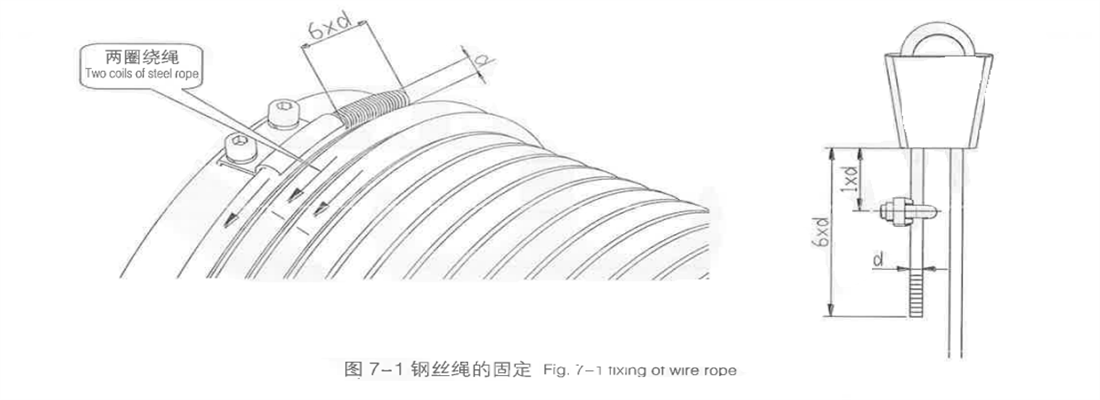
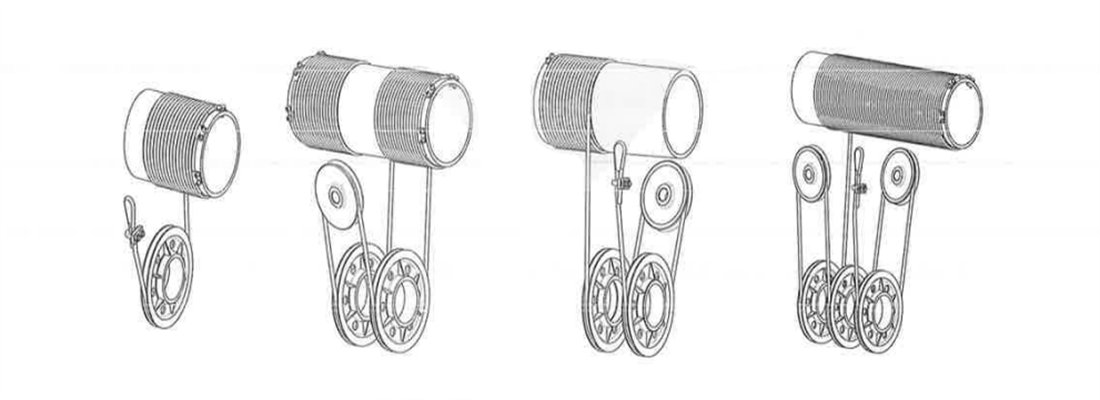
.png)
| Table 7-2 Lubrication Table | |||
| Lubrication locations | Refueling cycle | Fule adding measures | Recommended oil (grease) |
| Wire rope | 1 time/six months | Daub | oil (grease) for wire rope special |
| Lifting gear box | 1 time/three months | Upper hole infusion | Industrial gear HL-20 |
| Travelling gear box | 1 time/three months | Upper hole infusion | Industrial gear HL-20 |
| Table 7-3 Lubrication oil volume | ||
| Lifting capacity (t) | Lifting gear box Oil injection volume(L) | Travelling gear box Oil injection volume |
| 0.5 | 0.45 | 0.1 |
| 1 | 0.65 | 0.1 |
| 2 | 1.15 | 0.1 |
| 3 | 1.65 | 0.1 |
| 5 | 2.35 | 0.2 |
| 10~16 | 3.55 | 0.2 |
| 20~32 | 3.55 | 0.2 |
| Common faults | main reason | Troubleshooting |
| The motor starts reluctantly and makes a loud noise, unable to lift the load | 1. The power supply voltage is too low; 2. The brake is not safely disengaged; 3. Overload. |
1. Adjust the power supply voltage; 2. Adjust the brake clearance; 3. Load limiting |
| The electric hoist runs continuously in one direction | 1. Button stuck; 2. Contactor contact bonding |
1. Repair button; 2. Repair or replace the contactor |
| The gourd shell is live or there is abnormal noise from the running motor | 1. The I-beam is not grounded; 2. There is insulation damage to the motor or electrical device. |
1. The I-beam is not grounded; 2. There is insulation damage to the motor or electrical device. |
| Contactor contact burnt out or transformer burnt out | 1. The power on voltage is too high or too low; 2. The ambient temperature is too high and the humidity is too high |
1. Ensure voltage stability; 2. Ensure that the temperature and humidity meet the usage environment. |
| Braking failure or excessive braking distance | 1. Excessive brake clearance; 2. Oil stains on the braking surface; 3. Loose brake ring; 4. Pressure spring fatigue: 5. Poor contact between the brake ring and the conical surface of the rear end cover; 6. The coupling does not move properly or is stuck. |
1. Adjust the clearance according to 4.3.1; 2. Remove and clean the oil stains; 3. Replace the brake ring; 4. Replace the spring; 5. Dismantling and grinding; 6. Check its connection part |
| The temperature rise of the motor exceeds the upper limit of the nameplate | 1. Brake clearance too small: 2. Homework is too frequent; 3. Overload. |
1. Adjust the clearance; 2. Reduce the frequency of homework; 3. Load limiting. |
| The reducer has significant abnormal noise | 1. Poor lubrication;2. Damaged components such as gears and bearings; | 1. Add lubricating oil; 2. Replace damaged components. |
| Reducer oil leakage | 1. Poor or damaged sealing assembly between the box and the box cover. 2. Excessive refueling. |
1. Check or replace the oil seal; 2. Drain excess grease. |
| The steel wire rope is out of groove or tangled, and the rope guide is damaged | Side pulling and inclined lifting | Follow safety regulations for operation |
| Car wheel slipping | Oil stains and other coverings on the I-beam track or wheel tread | Remove the cover and sprinkle sand if necessary. |
| When starting and running, the body shakes and runs poorly | Improper clearance between the side of the I-beam lower flange and the inner side of the wheel flange. | Adjust the number of washers to maintain a reasonable gap. |
| The limiter is malfunctioning or the limit position is not appropriate. | 1. The stop block on the limit lever is loose or improperly positioned. 2. Power supply error |
1. Adjust and tighten the stop block; 2. Adjust the power supply. |
.png)

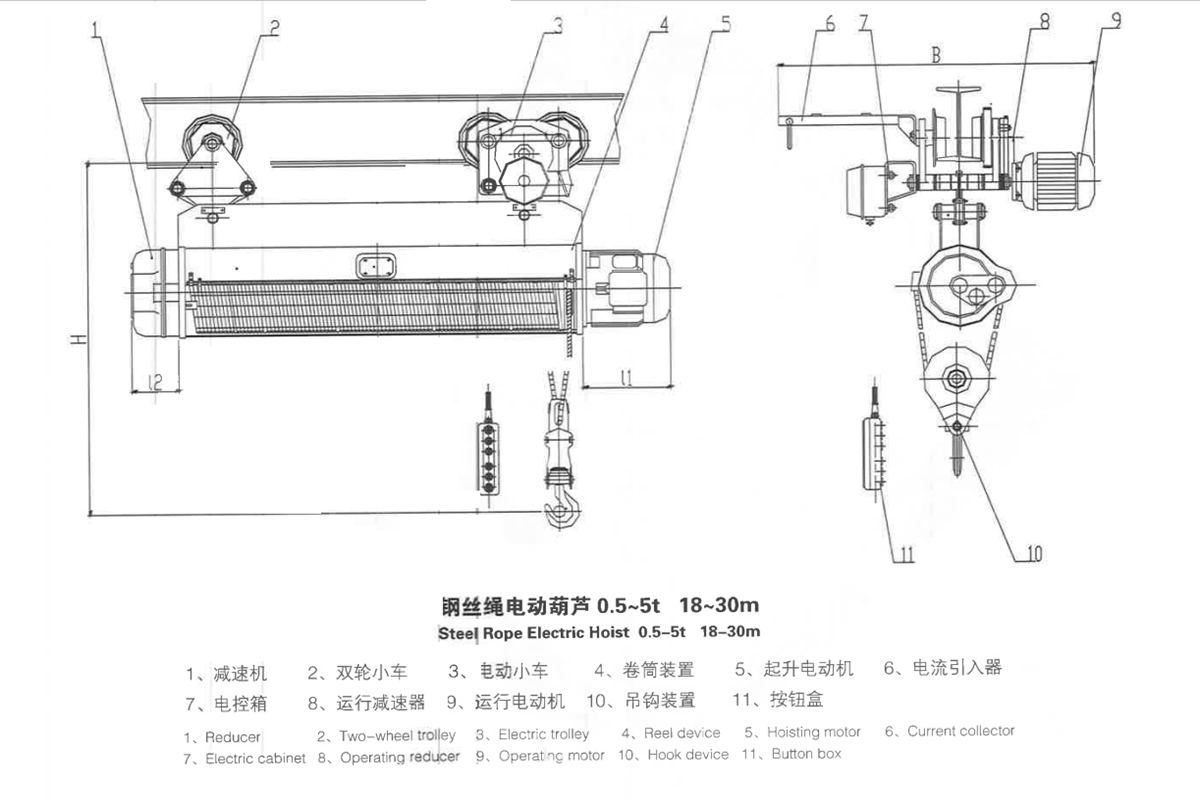
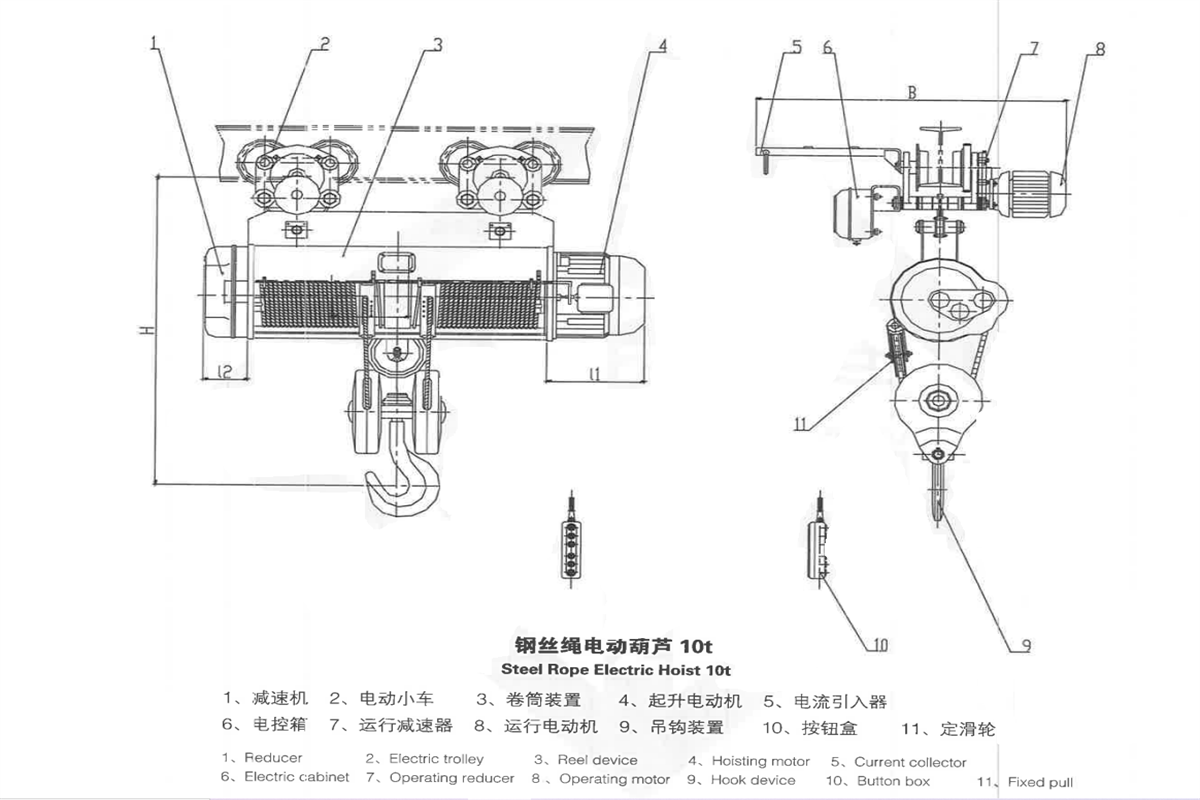
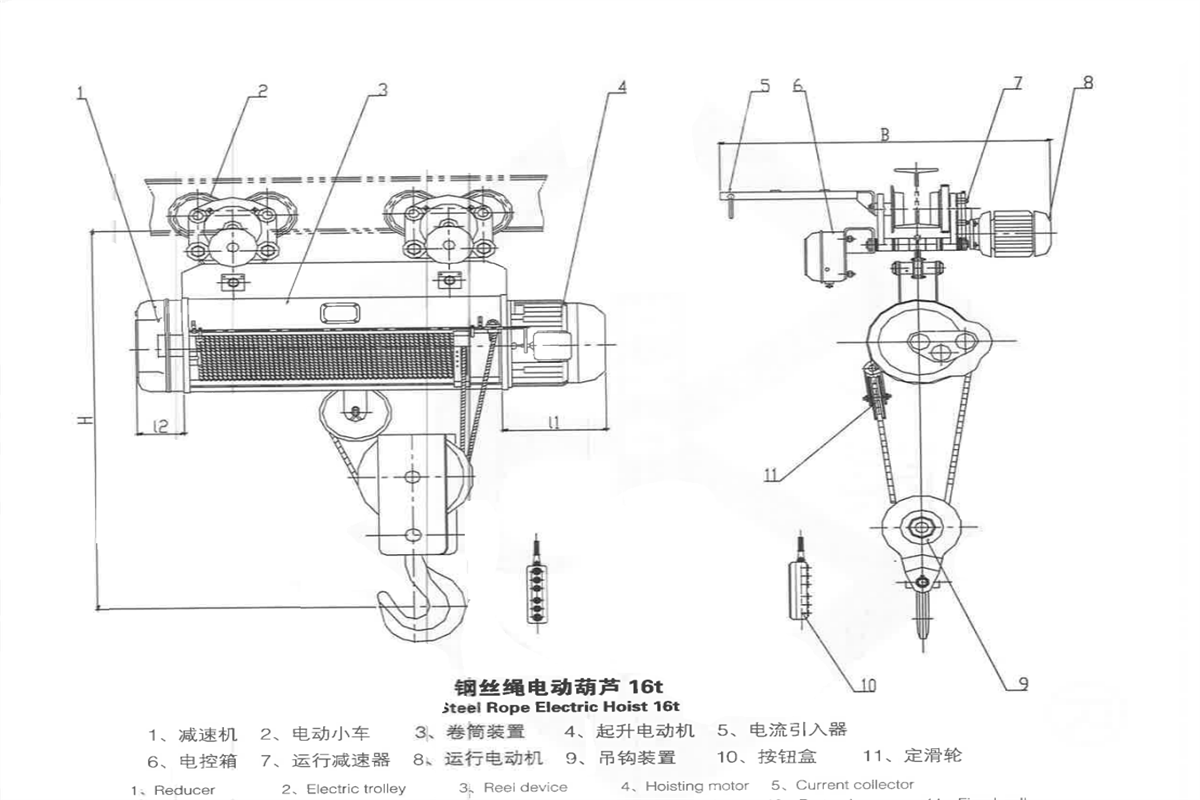
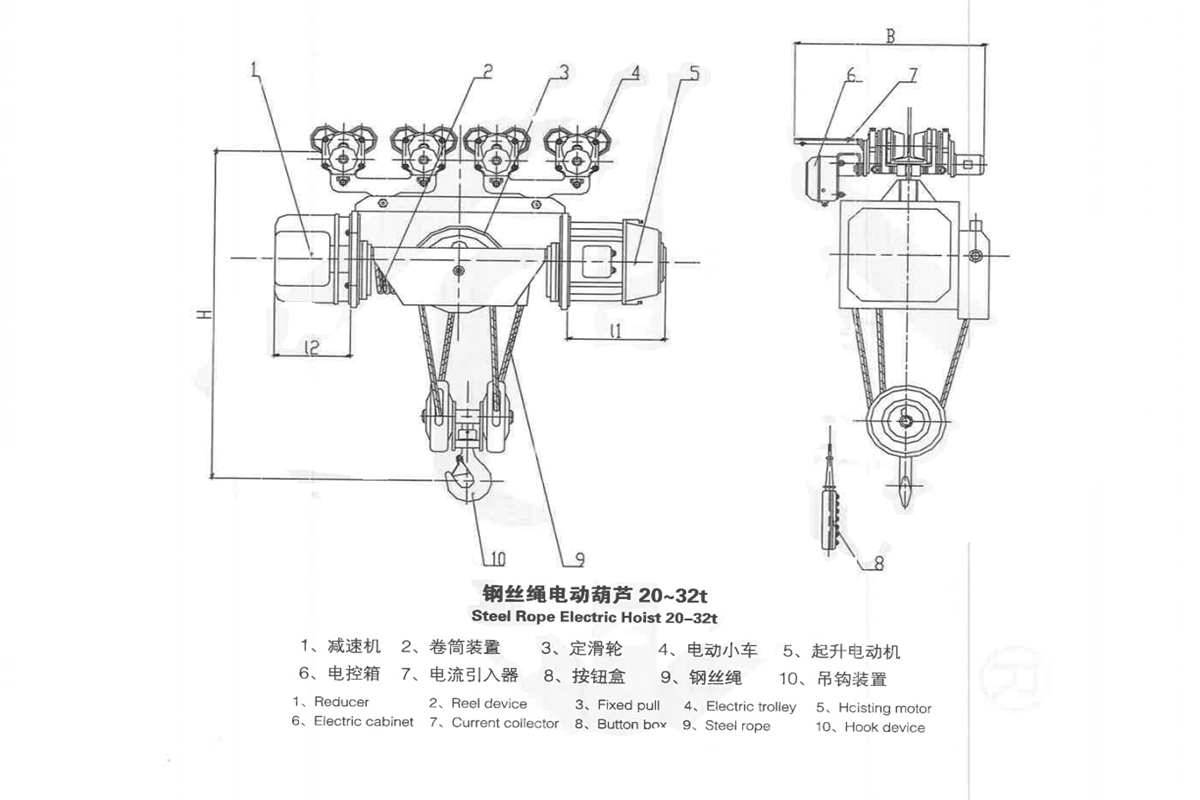
.png)
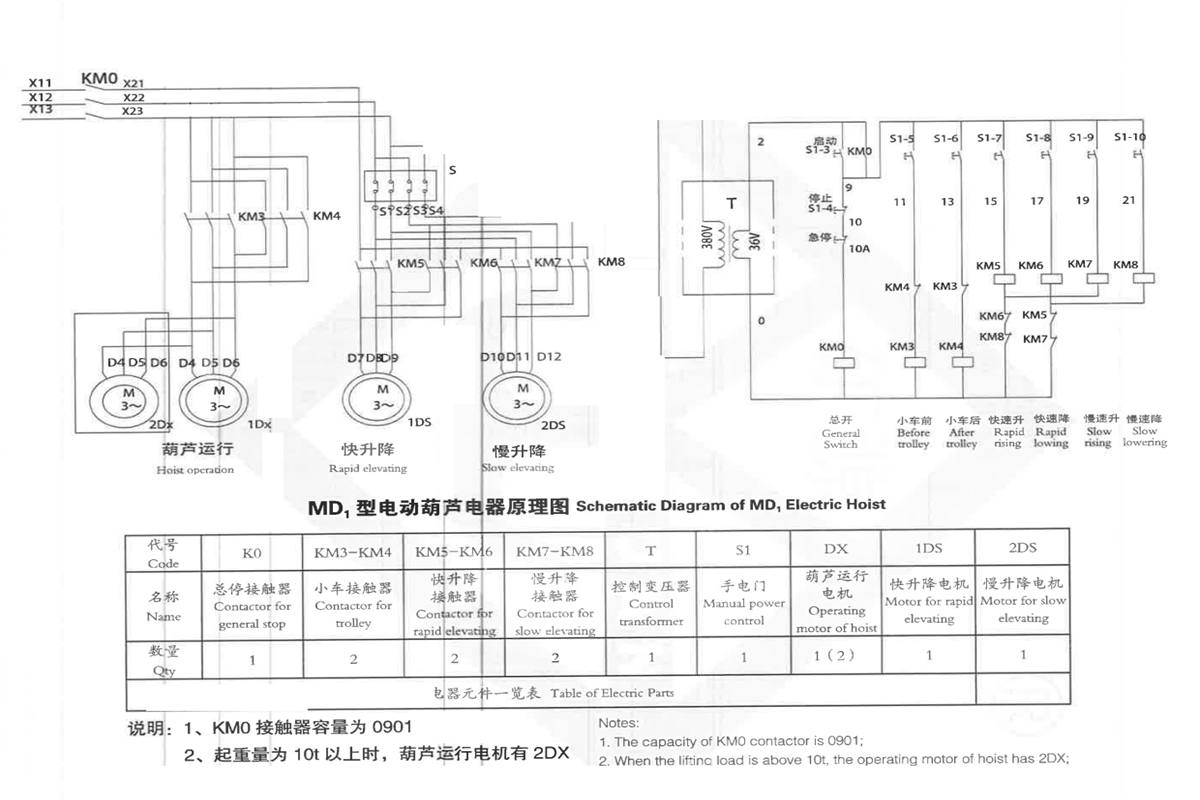
.png)
